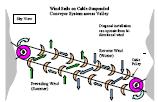|
The cable systems that form the basis of suspension
bridges can be adapted to wind power generation and may be ideally suited
for turbines that rotate on a transverse axis, such as the design from
BroadStarTM.
A cable suspension system allows several of the BroadStar units to be
coupled to each other via a flexible drive connection and drive into a
single alternator. In some valleys the power generation units may be
placed 500 ft to 1000 ft above the valley floor, above a river or above an
oceanic channel. The alternators may be positioned close to the valley
walls where it would be easier to absorb torque reactions. A system of
counter-rotating turbines would neutralize the torque reactions and allow
greater freedom in the placement of the alternators. Several successive
batteries of cable suspended turbines may be installed across
valleys in regions that experience predominantly unidirectional winds.
Cable-suspension systems may also allow for the installation of a conveyor
system of multiple vertical-axis turbine blades that drive into a single
alternator. The blades move upwind in a relatively straight line near the
valley walls where the boundary layer effect would help reduce aerodynamic
drag. A large number of blades moving downwind capture all or part of the
wind energy and exert greater tensile force on the cables that drive the
alternator. The conveyor system borrows from the research of
Dr Wubbo Ockels
from Delft University in the Netherlands and moves the conveyor
horizontally instead of vertically.
Cable systems may also suspend giant
windbelts at high elevation in windswept valleys. The wind would
ideally induce sinusoidal movement in the windbelts and this energy may be
converted to electric power. Airfoils may be added to the giant windbelt
so as to enhance the potential to generate electrical power. The airfoils
may operate on the free-wing concept so as to reduce the amount of energy
needed to steer them. Transverse pairs of wings attached to the front and
rear of each alternative section of the windbelt could help induce and
maintain sinusoidal cyclical movement about the transverse axis.
Rudders attached to the front and rear of each alternative section of the
windbelt would induce sinusoidal cyclical movement around the vertical
axis. Cables attached to the front and rear of rudder-equipped sections
would connect to the winch-and-clutch mechanisms mounted on the valley
walls to drive alternators.
There is much ongoing research into the field of airborne and towerless
wind energy conversion. Cable-suspended wind-generation systems
installed across or along valleys offer the potential to generate large
amounts of electric power while avoiding many of the problems associated
with tower-based wind-power generation.
Harry Valentine
[Bold and links are editorially added.] [TOP] |


And see more:
Advance on valley-wind-energy capture by
Harry Valentine
for bi-directional system |


